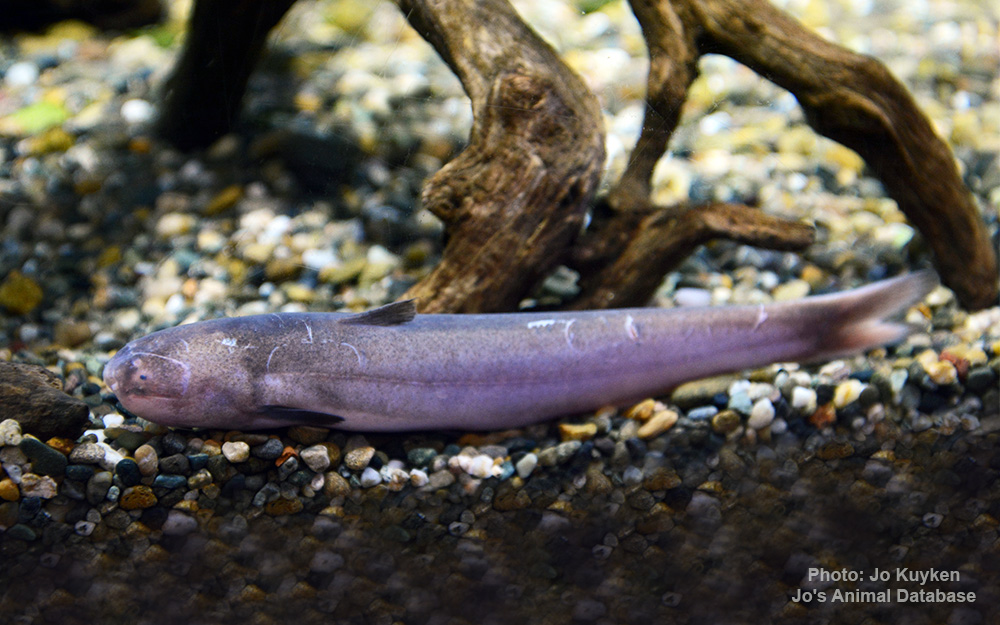Candiru-Acu
(Cetopsis candiru)

Image source: Jo's Animal Database
Classification
General data
Cetopsis candiru, also known as candiru, candiru açú, candiru cobra or canero, is a carnivorous species of whale catfish found in the Amazon basin of Peru, Brazil and Bolivia. Similar to Cetopsis coecutiens, Cetopsis candiru is a large species of the genus Cetopsis and a widespread scavenger, known for its voracious feeding and the habit of burrowing into the carcasses of dead animals and humans. Despite its name, it is not closely related to the bloodsucking Candiru (Vandellia cirrhosa).
The body of Cetopsis candiru is elongated and smooth with a broadly rounded, triangular head. The eyes are located on the dorsolateral surface of the head and situated far towards the front of the skull within the first fifth of the head length. They are small, only around as large as the circular anterior nares, which are surrounded by a rim of skin. In addition to the anterior nares, Cetopsis candiru also possesses a second pair of nares further back on the skull that open towards the top of the body, which are also surrounded by tubular skin.
The mouth is located low on the head and around half as wide as the head is long. The margins of the lower jaw are shortened and reach approximately as far back as the eyes. The teeth of the premaxilla are incisiform and form a single, gently curved row. In addition to them C. candiru also possesses teeth on the vomer which share their incisiform morphology with those of the premaxilla and are likewise arranged in a single curved row. Finally the dentary mimics the same tooth arrangement, if notably larger compared to the premaxillary and vomerine dentition. Through this C. candiru differs from its relatives, known for having conical teeth on the vomer and dentary.
Like many other species of catfish, Cetopsis candiru has long, whisker-like growths known as barbels. The maxillary barbels are about a third of the length of the skull and originate below the front-most edge of the eyes. Two pairs of mental barbels are present on the lower jaw and equal in length and size to those of the maxilla.
The dorsal fin is relatively small and located towards the front of the body, lacking spines. The base of the caudal fin (caudal peduncle) is approximately as deep as it is long. The caudal fin itself is symmetrical and slightly forked, with the rounded lobes approximately 1.5 to 1.6 times longer than the shallowest part of the fin. The anal fin is located in the back half of the body and its base takes up approximately a third of the animal\\\'s length. Its shape is gently convex and its rear end does not attach to the body. In Cetopsis candiru the pelvic fins are short and paddle-like with rounded symmetrical edges. Like with the anal fin, there is no membrane attaching the last fin ray directly to the body. Finally the pectoral fins are around half as long as the head with rounded edges.
Mature males however differ from females and juveniles in the morphology of some of their fins. The first fin rays of both the dorsal and pectoral fins are distinctly elongated beyond what can be seen in younger or female individuals and the anal fin is noticeably more convex. When this sexual dimorphism sets in is not fully known. The smallest specimen showing all of these traits measured 145 mm (5.7 in) in standard length (tip of the skull to the end of the hypural plate). Another, smaller individual measuring 137 mm (5.4 in) shows the onsets of these elements growth.
They range in size from 1.8 cm (0.71 in) to 26.3 cm (10.4 in).
Cetopsis candiru is known across large parts of the Amazon Basin. Specimens have been discovered in Brazil close to the Amazon River itself, the Rio Tocantins, the Rio Negro, the Rio Purus and the Rio Madeira among others. In Bolivia they occur in various tributaries to the Rio Madeirda such as the Rio Beni and in Peru they were recovered from the Rio Ucayali and other tributaries to the Amazon. Some scientists also report the presence of Cetopsis candiru from eastern Ecuador.











